Leaders of the Republican-controlled Senate have revealed a plan to blow past the bipartisan spending caps by $300 billion through 2019. (See Chart 1.) What accounts for this spending blitz?
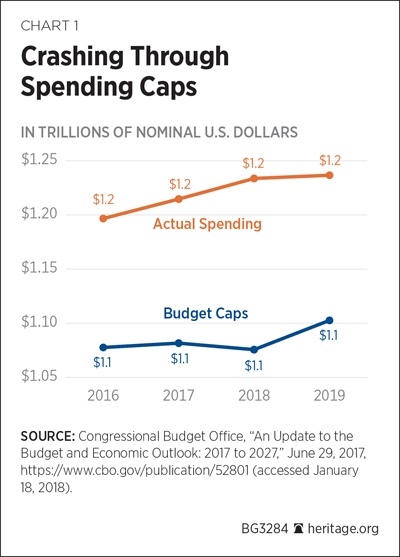
Republicans want to spend more money on national defense, and in his State of the Union speech, President Donald Trump proposed ending “the defense sequester.” Democrats aredemanding an equal amount ofextrafunding for domestic social welfare programs, so to get an additional $108 billion for the Pentagon, the Republicans are nearing agreement on another $108 billion-plus in ransom money for domestic agencies.
But even this dollar-for-dollar trade is misleading. When all of the emergency funding is included, the ratio could be closer to $2 of additional domestic spending for every dollar of increased military funding. Republicans, in other words, appear to have fallen into a liberal trap.
If this deal to raid the Treasury is finalized, the budget caps from the Budget Control Act of 2011 (BCA) will be officially and irrevocably washed away. With the extra spending, the $4 trillion federal budget will exceed $5 trillionwithin eight years. The $20 trillion debt is already headed to $30 trillion over the next decade—even without this excessive new spending.
This would also seriously undermine the BCA, which instituted spending caps and sequester cuts if those caps are exceeded.The BCA caps have worked remarkably well to repel the very kind of spending blowout that we are now seeing from Congress.
When the BCA wasfirst installedduring Barack Obama’s first term(and after Republicans seized control of Congress in the 2010 elections), federal spending fell for three years in a row,from $3.6 trillion in 2011 to $3.51 trillion in 2014.This was thefirst time that had happened since the 1950s. Remarkably, in 2016, discretionary spending was actually lower than it had been in 2011. The spending binge of President Obama’s first two years came to a hard stop.
We estimate that the cumulative savings from the caps since 2011 have exceeded $1 trillion. Congress wants to end the BCA not because it has failed, but because the caps on spending have been too successful. The pro-spending forces have come to despise the BCA’s fiscal handcuffs of budget caps and the threat of across-the-board sequester cuts.
Republicans have rightly complained that at least two-thirds of the discretionary savings from the caps has come from cuts in defense spending, not from cuts in spending on domestic programs, but agreeing to spend $2 for more domestic spending for each dollar of new defense spending is too high a price to pay. Instead, they should work to make the caps apply to all federal spending—including entitlements.
Donald Trump’s first budget back in February rightly called for the elimination of scores of ineffective, wasteful, and obsolete federal programs, from transit subsidies to wind and solar power handouts to foreign aid boondoggles, but he may soon be presented with a budget that shelvesalmost all of those money-saving cuts. Trump’s budget was below the spending caps, but the House budget resolution exceeded them.
Another $300 billion in excess federal spending is no way to drain the swamp.Trump should use his veto pen to save the country from another unaffordable federal spending spree.
The BCA Is Working to Restrain Spending
The Budget Control Act of 2011 was enacted on August 2, 2011, and established limits on discretionary spending through fiscal year (FY) 2021.[REF] The BCA caps and sequester are a byproduct of the famous 2011 “debt ceiling” negotiations between President Obama and House Speaker John Boehner (R–OH). Federal spending had soared to 24.4 percent of the economy during Obama’s first two years in office and appeared to be headed to more than 25 percent of the economy without new spending limits.
Despite its flaws, the BCA has been one of the most successful restraints on federal spending in modern times. Before those negotiations, the federal government was spending 24.4 percent of gross domestic product (GDP). From 2014–2017, expenditures have been below 21 percent of GDP. We estimate that from 2011–2017, the BCA has saved roughly $1 trillion from the spending that had been expected.
The Budget Control Act is one of the reasons that the budget deficit fell from the towering heights of more than $1.4 trillion of red ink in 2009 to less than $500 billion in 2014. (See Chart 2.) In 2017, the deficit shot back up to $666 billion as a result of growing entitlement programs and rising interest payments on the government’s debt.
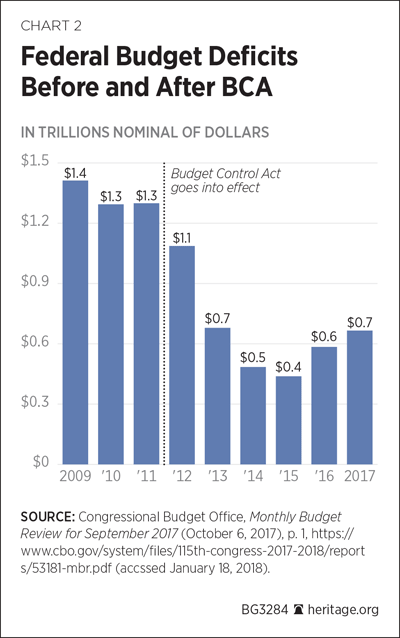
The BCA budget caps explain the drop in total federal outlays (in nominal dollars) from $3.603 trillion in 2011 to $3.506 trillion through FY 2014. This is the first three-year stretch of declining federal outlays since Dwight Eisenhower’s first term in office. (See Chart 3.) From 2011 to 2017, the growth in federal spending in inflation-adjusted terms was zero.
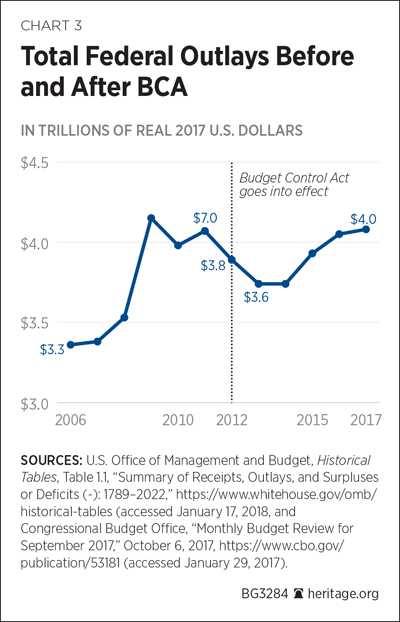
To fully appreciate this turnaround in budget policy, one must consider the breadth of the Washington spending binge beginning in George W. Bush’s last full year in office through Barack Obama’s first two. From 2007 to 2011, federal expenditures sprinted forward by $874 billion in nominal dollars—a nearly one-third blowout during an era of modest inflation (less than 10 percent cumulative). From 2011 to 2014, spending fell by $97 billion. (See Chart 4.) Since 2014, thanks to upward revisions in the spending caps, outlays have risen, but at a much slower pace than had been projected.
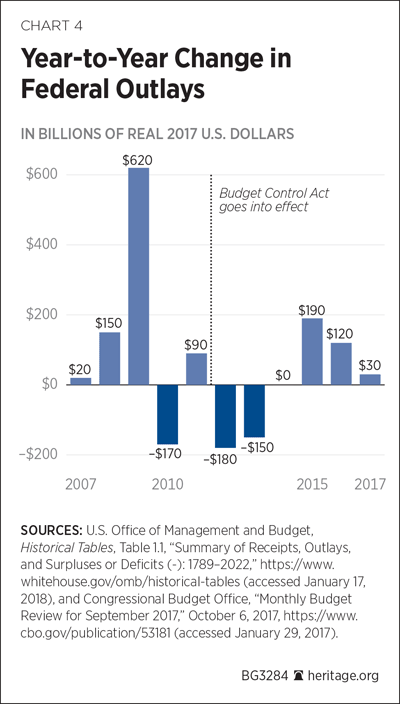
Spending cuts have been positive for the economy. Total government spending as a percentage of GDP plummeted from 24.4 percent in 2009 to 20.3 percent in 2014. (See Chart 5.) From 2011 to 2014 alone, discretionary spending dropped by 2 percentage points of GDP. The economic growth rate, although still far too low, has crept upward as government spending has fallen. There is no evidence indicating that spending cuts have restrained economic growth, despite the predictions of many economists.
Today, federal spending is roughly 3 percentage points lower as a share of GDP than it was in 2010. This is the equivalent of at least $500 billion (based on the GDP in 2014) in resources remaining in the private sector each year rather than being squandered by the federal government. This constitutes one of the largest fiscal retrenchments in modern times. The combination of budget control, regulatory rollback, and tax cuts is a major reason why the economy has surged during this past year.
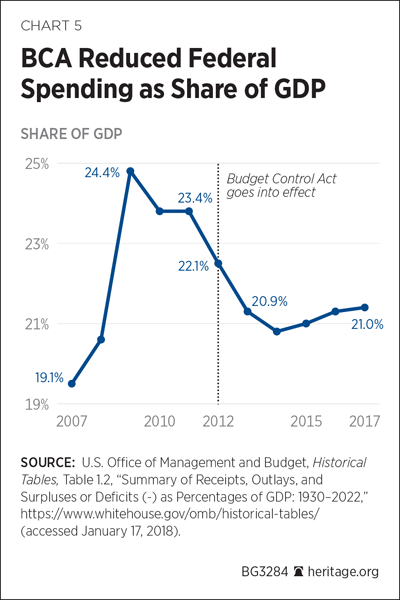
Defense Has Absorbed 77 Percent of the Budget Cuts
The good news is that the caps have restrained discretionary spending. After peaking in 2011 at $1.347 trillion, discretionary spending was reduced to $1.179 trillion in 2014—a 12.5 percent three-year cut in agency spending, not from the baselines but in nominal dollars spent. Adjusting for inflation, these programs have been cut by 16 percent. (See Chart 6.)
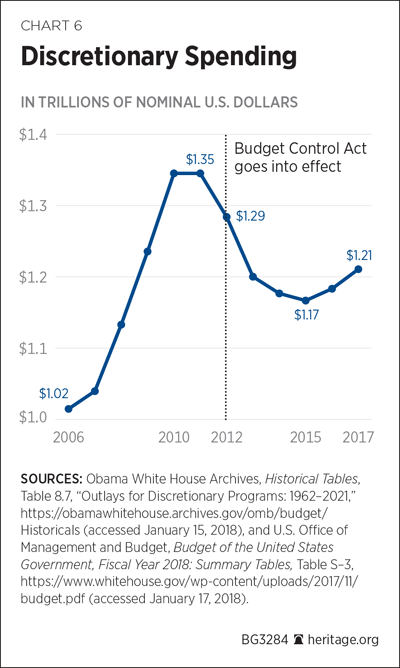
Actual discretionary spending (in nominal dollars) from 2011 to 2017 was $1.15 trillion lower than projected by the Congressional Budget Office (CBO) in January 2011 before implementation of the budget caps.[REF] The BCA caps and sequester made this reduction possible. (See Chart 7.)
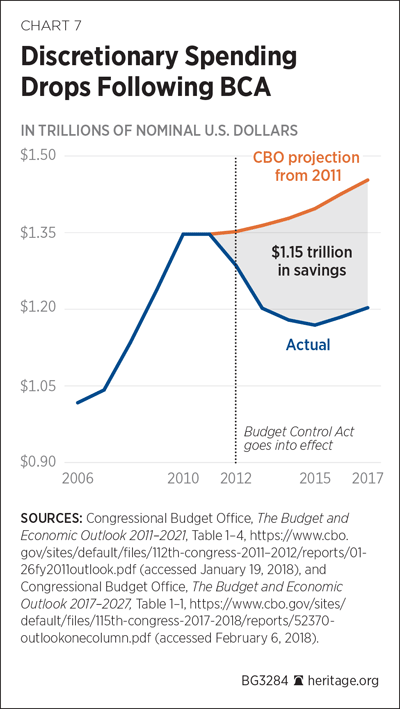
One unfortunate effect of the BCA is that defense has taken the brunt of the budget cuts. We estimate that more than three-quarters of the actual reductions in discretionary spending have come from defense rather than non-defense spending. (See Chart 8.) Some of the cuts in defense spending probably would have occurred even without the BCA caps. At that time, the U.S. military was winding down from the wars in Iraq and Afghanistan. In real terms, more than $100 billion has been cut from the defense budget dating back to 2011—a significant reduction.
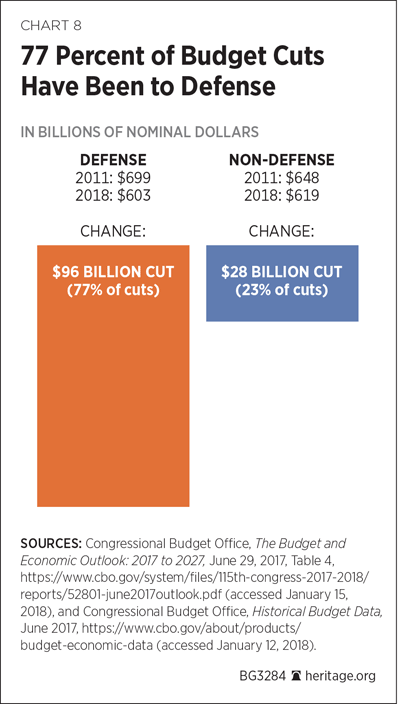
The BCA’s Biggest Flaw: No Entitlement Cuts
The major explanation for the military’s taking a disproportionate share of the spending cuts is that entitlement spending on Medicare, Medicaid, Social Security, and other welfare programs (well over half of the budget) continues to grow on autopilot. These income transfer programs are largely outside the BCA’s caps and largely untouched by its sequester cuts. (Medicare and some other mandatory programs have absorbed minor cuts from the sequester process, but the actual benefits are immune from the caps.)
That is a problem because the budgets for the big three programs—Medicare, Medicaid, and Social Security—and Obamacare subsidies are expected to nearly double (85 percent growth) from 2016 to 2027. (See Chart 9.)
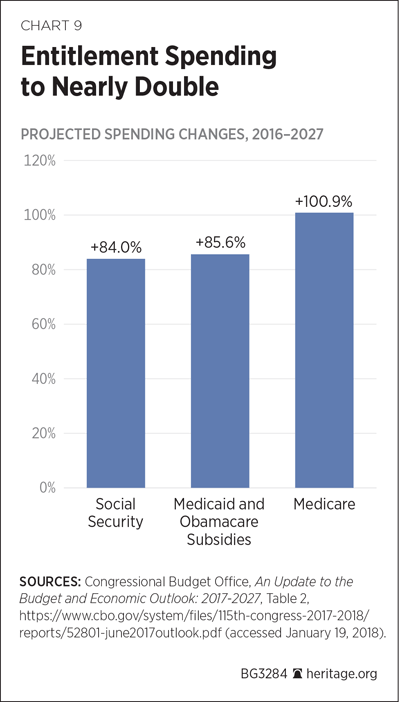
Breaching the Spending Caps
Congress hasalready lifted the original BCA caps multiple times since the law’s enactment. This is unrelated to the tens of billions of dollars in discretionary spending each year for overseas contingencies and emergencies not subject to these caps. The savings from the BCA might be twice as large if Congress had not continually raised the caps. (See Chart 10.)
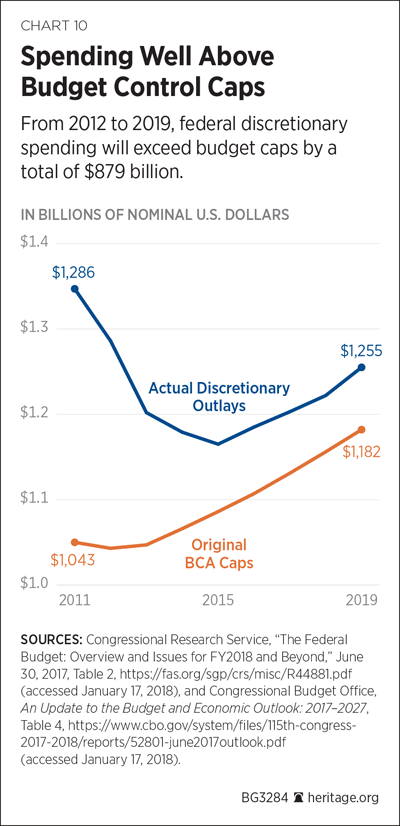
For 2018 and 2019, it is expected that the caps will be exceeded by more than $100 billion each year, and the total could reach $150 billion with disaster and other “emergency” funding without a veto from the President. This increase in spending will very likely add to the baseline level of spending for the future years as well, so a two-year $300 billion breach of the caps could lead to well over $2 trillion in added deficit spending over the next decade.
How to Save and Strengthen the BCA Spending Caps
The BCA caps and sequesters are the only fiscal safeguard left standing, and they need to be retained. They also need to be fixed. Four sensible changes would improve and modernize the law:
- Remove the defense/non-defense “firewall.” If Congress removed the firewall between defense and non-defense spending and imposed one overall cap, lawmakers would have more flexibility in staying under the cap each year.
- Repeal sequestration exemptions. If a sequester kicks in, cuts should apply equally to all programs, including Medicaid, Medicare, and food stamps. This would spread the pain more equally if sequester cuts are necessary.
- Prohibit funding “emergency” spending exemptions (including disaster loans and Small Business Administration loans) to breach the caps. This year, Congress has approved roughly $50 billion for hurricane relief with no cuts in other programs to offset the cost. The Overseas Contingency Operation also has been used to spend an extra half-trillion dollars on the military. This should not be used to prop up the base Department of Defense and Department of State budgets; it should be phased out entirely and funded through the regular appropriations process.
- Establish a global federal spending cap of 2.5 percent growth annually for all programs (excluding interest on the debt). If some programs, such as Medicare, grow by more than 2.5 percent, other programs will have to grow by less than that amount. This cap would be above the expected rate of inflation for the next decade but would put pressure on Congress to restrain entitlement spending. If Congress exceeds these caps, the sequester should apply to all non–Social Security payments. This spending cap plus 3 percent growth in the economy would produce a balanced budget after 10 years.
These BCA fixes would be a constructive first step toward the ultimate goal of scrapping and replacing the defunct and corrupt Budget and Impoundment Control Act of 1974 (1974 Budget Act).[REF] The 1974 act has produced budget deficits in all but three years since its inception 45 years ago. Almost all of the current $20 trillion of national debt has been borrowed since the 1974 Budget Act became law. This is because that law has tilted the budget process toward exponential growth in spending and trillions of dollars of debt.
Conclusion
The Budget Control Act of 2011 is far from ideal, but it has produced beneficial results for the U.S. federal fiscal situation. Under the BCA, total federal outlays have fallen from more than 24 percent of GDP in 2010 to 21 percent in 2017. Thanks to the BCA, discretionary spending is actually lower today in nominal terms than it was in 2012.
Enforcing the caps is also the best way to keep the pressure on Congress to reform the massive entitlements, the future growth of which translates into escalating debt burdens (up to 150 percent of GDP by 2030).
What is clear is that if Republicans strike a deal with Democrats in Congress to exceed the spending caps again this year, the BCA will be dead, and we will be back to the Wild West of spending. (The move to restore earmarks, for example, is a symptom of this pro-spending virus.) To borrow a phrase from P.J. O’Rourke, eliminating spending caps is about as wise as handing a teenager the car keys and a bottle of booze.
—Stephen Moore is Distinguished Visiting Fellow in the Project for Economic Growth, of the Institute for Economic Freedom, at The Heritage Foundation. Andrew Wofford is a Special Assistant and Research Associate in the Project for Economic Growth.




